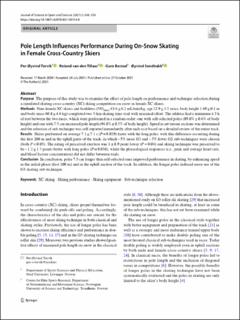Pole length influences performance during on-snow skating in female cross-country skiers
Peer reviewed, Journal article
Published version

Åpne
Permanent lenke
https://hdl.handle.net/11250/2983908Utgivelsesdato
2021Metadata
Vis full innførselSamlinger
Originalversjon
Torvik, P.-Ø., van den Tillaar, R., Bostad, G. & Sandbakk, Ø. (2021). Pole length influences performance during on-snow skating in female cross-country skiers. Journal of Science in Sport and Exercise, 3, 348-354. doi: 10.1007/s42978-021-00134-0Sammendrag
Abstract Purpose The purpose of this study was to examine the effect of pole length on performance and technique selection during a simulated skating cross-country (XC) skiing competition on snow in female XC skiers. Methods Nine female XC skiers and biathletes (VO2max 63.6 ± 6.2 mL/min/kg, age 22.9 ± 3.5 years, body height 1.69 ± 0.1 m and body mass 60.8 ± 4.6 kg) completed two 5-km skating time-trail with maximal effort. The athletes had a minimum 4.5 h of rest between the two races, which were performed in a random order: one with self-selected poles (89.0% ± 0.6% of body height) and one with 7.5 cm increased pole length (94.0% ± 0.5% of body height). Speed in set terrain sections was determined and the selection of sub-technique was self-reported immediately after each race based on a detailed review of the entire track. Results Skiers performed on average 7.1 ± 7.1 s (P = 0.029) faster with the long poles, with this difference occurring during the first 200 m and in the uphill parts of the track, in which ~ 5% more G3 and ~ 5% fewer G2 sub-techniques were chosen (both P
